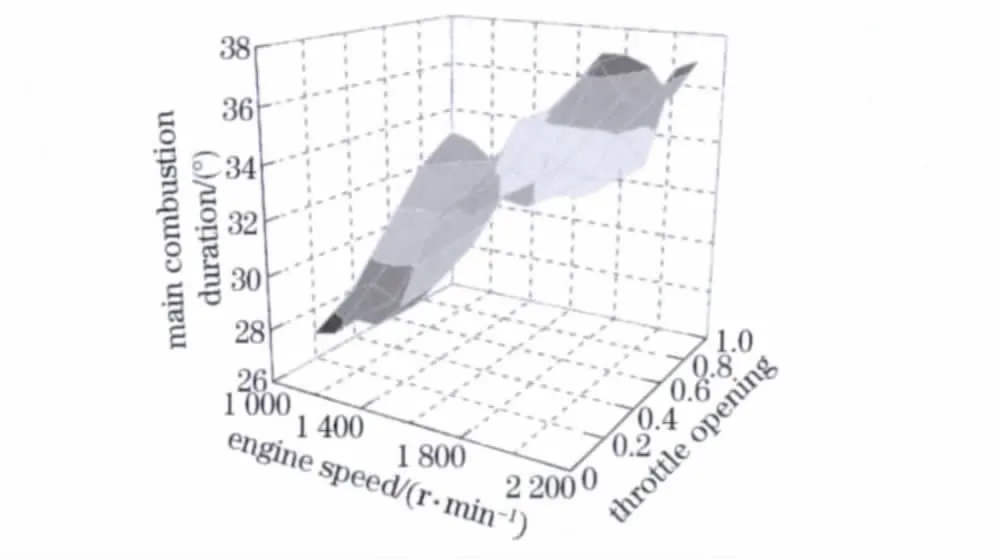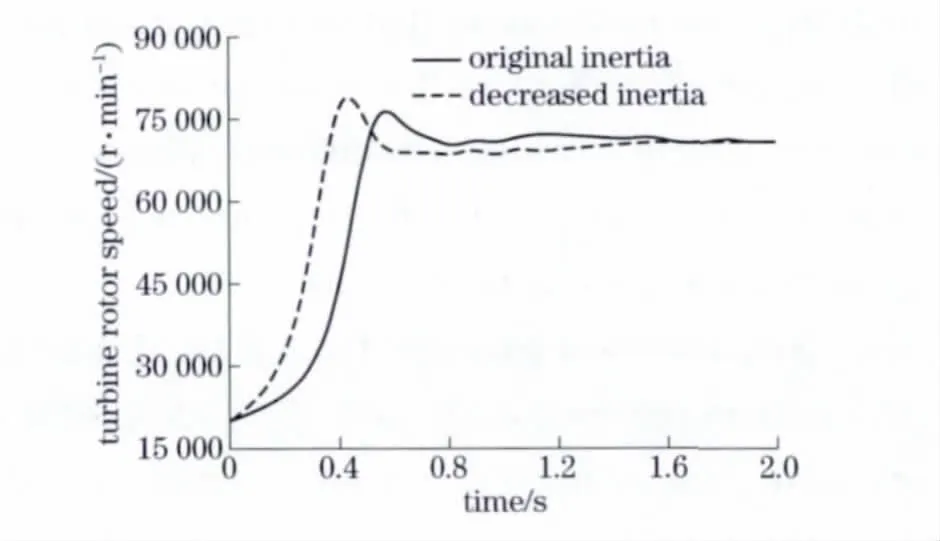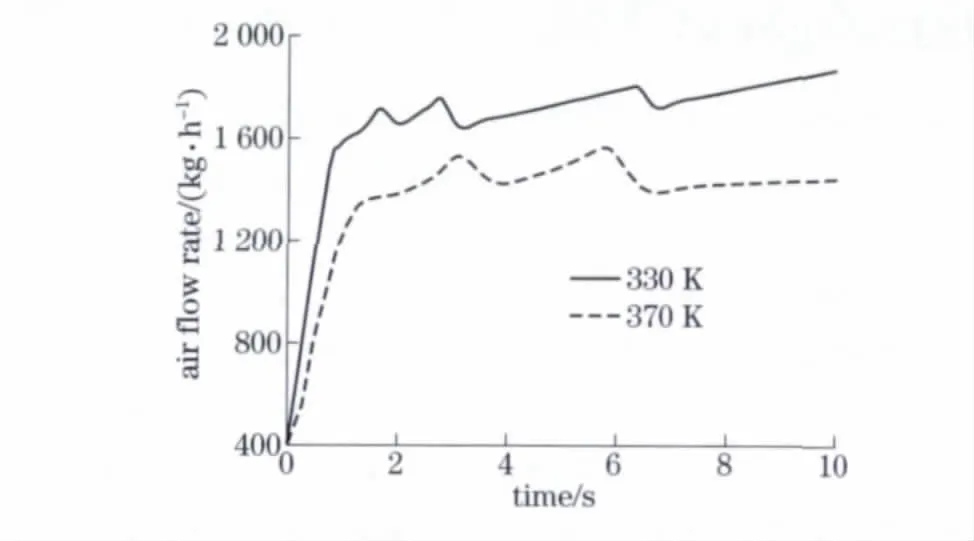Analysis of vehicle powertrain dynamic performance
2013-11-05LUOGuoliang罗国良ZHANGFujun张付军YUANHaojie袁豪杰
LUO Guo-liang(罗国良), ZHANG Fu-jun(张付军), YUAN Hao-jie(袁豪杰)
(1.School of Mechanical Engineering,Beijing Institute of Technology,Beijing 100081,China;2.Beijing Research Institute of Mechanical&Electrical Technology,Beijing 100074,China)
Vehicle's acceleration performance and fuel economy are importantindicatorsto measure combat capability and viability for tracked vehicles.With actual operating and load conditions,vehicle powertrain system works under dynamic operating conditions.Research shows that when the vehicle is running on the road,the engine load and speed and other parameters are also in a state of flux,and 66%to 80%of the total operating conditionsare dynamic conditions[1]. For tracked vehicles,the proportion of dynamic operating conditions is even higher and the driving mode is complex,because they normally travel on the plains,plateau,desert and hills,etc.,rarely on the highway.Therefore,the results of vehicle dynamicssimulation are close to the vehicle's actual operating conditions,and can predict vehicle performancemoreaccurately and guide the vehicle powertrain matching and optimization of the design.The dynamic simulation method is of great significance to accelerate the vehicle development cycle and reduce development cost.
1 Theoretical analysis of the dynamic model
In the vehicle development research and the vehicle matching process,it is often necessary to analyze and calculate the performance of powertrain components,so as to achieve a good match and optimal design of the power transmission device[2].The powertrain components mainly include the engine,hydraulic torque converter and gearbox.In this paper,the forward simulation modeling approach was used to develop vehicle powertrain dynamic model,including the driver model,engine model,the torque converter model,gearbox model,vehicle dynamics model and typical vehicle driving cycle model.
In the turbo diesel dynamic simulation process,some parameters of the engine are not set in advance,which is different from the stead-y-state process calculation[3].These parameters are functions of time,and change with the variety of engine performance;while the engine perfomance depend on the vehicle load,moment of inertia and the running time.In this paper,turbo diesel engine dynamic model was designed based on the idea of transforming steady-state model into dynamic model.We first established turbo diesel steady-state simulation model in GT-Power[4],and verified the model using the steadystate engine bench test data in order to make sure the accuracy of the model meet the needs of the transformation into a dynamic model.Secondly,by examining test data and the results of steadystate model, we selected typical parameters,which change significantly with the engine operating conditions,to form a function of engine speed or load and establish the engine map that changes with speed and load.These map data will provide boundary conditions for the dynamic process calculation,by using table look-up method based on these engines work operating pointposition.Therefore,the model is capable of changing with the speed or load and making the appropriate response;external load are applied to the engine dynamic model and provide dynamic variable load to balance the engine torque.Finally,we set some parameters,such as the GT-Power software calculation mode,to obtain simulation results of the engine dynamic process.
2 Modeling
A turbo diesel engine model was established based on DEUTZ BF6M1015CP diesel engine,using GT-Suite software.Specific parameters of the engine are shown in Tab.1,where D denotes the cylinder diameter,S denotes the stroke,ε is the compression ratio,n is the rated engine speed,and P represents the rated engine power.

Tab.1 Main parameters of diesel engine
According to the main technical parameters in Tab.1,the diesel engine is simplified as a calculation model,which composed of air intake system,exhaust system,the combustion ratio(cylinder),fuel injection system,supercharging system, intercooler, environmentalboundaries and the corresponding connecting pipe model,etc.
Cylinder model is core of the model[5].Models including geometric model,combustion model,the wall temperature and heat transfer model will be defined here.Among them,the combustion model is the most important because it determines series of processes including the cylinder gas mixture,combustion and heat release and has a decisive impact on the performance of the engine[6]. In thispaper, the entire combustion processisdivided into pre-mixed combustion phase,the mixing-controlled combustion phase and late burning phase,by using ternary Weber model.The combustion heat release rate curve can be given by the superposition of three Weber function curves[7],as shown below:

where X1,X2,X3denotes the fuel fraction of premixed combustion phase,the mixing-controlled combustion phase and late burning phase respectively.Each part of the combustion model starts at the same time,and has its own combustion duration and combustion index.
Experimental data are used as the inputs for turbocharger,intercooler and air filter modules.By adjusting the flow coefficient and heat transfer coefficient,the simulation results agreed well with the experimental data.Then,four typical parameters in the model were calibrated by the results of engine steady-state test so that the model can adequately reflected the characteristics of the engine under steady state operating conditions.These parameters were the engine power,air flow,engine fuel consumption rate and boost pressure,which were measured in 100%,80%,60%and 40%throttle opening under typical operating point.
The dynamic characteristic of hydraulic torque converter in unsteady conditions is defined as the relationship curves for the pump wheel dynamic torque,turbine shaft dynamic torque,angular velocity,speed ratio and time[8].Respectively,andare the dynamic torque of pump and turbine under the unsteady operation condition;are the dynamic hydraulic torque of pump and turbine under the unsteady operation condition;JPand JTare the pump(pump wheels and pump axle)and turbine(turbine and turboshaft)moment of inertia.
Based on Newton'slaw,a mathematical model of hydraulic torque converter in dynamic state can be expressed as

Mathematical formula of gearbox model can be expressed as

where Tiand Toare the input and output torque of gearbox,Niand Noare the input and output rotational speed of gearbox,igis the transmission ratio,J is the gearbox moment of inertia.
3 Experimental research
A test bench was designed and established,then we revised the model.The inlet flow was measured with the 20N125 hot-film air flow meter of Toceil Company.The cylinder pressure was measured with the transient cylinder pressure sensor of Kistler.The intake pressure and temperature of the cold air were measured with steadystate pressure sensor and thermistor of PT100.The exhaust pressure and temperature before turbine were measured with steady-state pressure sensor and K type thermocouples.The fuel consumption was measured with MF-3200 fuel consumption.
In order to simulate the combustion process in the cylinder under the dynamic conditions more accurately,the combustion heatrelease rate curve changed with the engine speed and load changes during the dynamic simulation of engine[9].Depending on the test data of the combustion heat release rate curve in different engine operating conditions,the three Weber combustion models of the GT-Power were studied to determine the value of each parameter.By selecting a different operating point,we got the combustion model under different conditions,with the interpolation methods to obtain the point between the two operating point and to get the variation of the engine combustion heat release rate under different conditions.Map of main combustion and quality factor are respectively shown in Fig.1 and Fig.2.

Fig.1 Map of main combustion duration

Fig.2 Map of main combustion quality factor
Since the engine speed changes with the external load under dynamic conditions,a fixed amount of fuel injection in a cycle can’t meet the requirements of the model.So we need to change the cycle fuel to achieve the changes of engine speed and load under dynamic conditions.If the map figure of cycle fuel in different speed and load is given,we can change the fuel under different conditions.Under the dynamic condition,the injection advance angle should be changed with the changes of engine speed and load accordingly.If the map figure of the injection advance angle under different speeds and loads is given,we can achieve the different injection advance angles under different conditions.The cycle fuel map and the injection advance angle map are shown in Fig.3 and Fig.4.
The flywheel-side gap of the engine in the tracked vehicles power compartment used in this test is small,so it’s difficult to install torque measuring device.We don’t measure the torque of engine output shaft directly,but measure the torque of the gearbox output shaft.We select the strain type torque sensorTQ101 ofBichuang Technology to measure torque.The measuring system of wireless torque sensor consists of wireless torque sensor nodes,gateways BeeNet network protocol,BeeData computer acquisition and processing software.

Fig.3 Cycle fuel map

Fig.4 Injection advance angle map
Wireless torque sensor node is connected with battery and strain gauges and fixed to the rotation axis,directly measuring the strain of the rotation axis,at the same time,transmitting the strain to the gateway node with wireless,to get the torque value with the use of acquisition and control software.Wireless gateway is responsible to transmit the received wireless data to a computer for storage,analysis and processing via computer interface.Wireless transmission eliminates the noise interference caused by long cable and slop ring,so the entire measurement system has the high accuracy and noise immunity.
We installed the vehicle speed sensor and engine speed sensor on the tested vehicle,and used the PXI-6624 calculator/timer capture board to collect signals of the vehicle speed and engine speed.The board consists of eight 32 bit counter/timers,and with optical isolation between channels,to support up to 48VDC input and output signals.NI PXI-6624 can be used to perform measurement tasks of a variety of counter/timer,including event calculation,period/frequency measurement,quadrature encoder position measurement,pulse width measurement,pulse generation and pulse train generation.
The road slope was measured by MTi attitude sensor from Xsens Technologies B.V in Dutch.MTi is a small inertial measurement with comprehensive three-dimensional magnetometer,which includes the processor that can do real-time calculation of three-axis acceleration,angular speed and magnetic field strength.Attitude sensor is fixed on the vehicle chassis,and the front of the vehicle is the x-axis direction,so the angle around the y-axis is the road slope.
Transmission is automatic transmission with torque converter.The solenoid valve of highspeed shift controls the hydraulic system to implement shift.The information collection of gear is the collection of the state of shift solenoid,shift solenoid signal is digital,with state of 0 and 1.PXI-6123's multi-synchronous acquisition card from NI Company is used in our test.It has a dedicated analog to digital converter(ADC)for each channel,so we can acquire the most powerful capacity and higher multichannel accuracy.NI PXI-6123 has 500 kHz adoption rate of each channel,four input ranged from ±1.25 V to ±10 V,two 24-bit counter/timers and eight hardwaretimed digital I/O lines,which is suited for a variety of applications.
The comparison of the transmission output shaft torque measured in the test and the simulation is shown in Fig.5.The comparison of the simulated engine fuel consumption of time course and the experimental values is shown in Fig.6.
Comparing the torque of transmission output shaft and vehicle fuel consumption,we can see the experimental data fit well with the simulation ones.So the model of simulation is satisfied for the accuracy requirements of vehicle dynamic analysis.

Fig.5 Torque comparison graph

Fig.6 Fuel consumption comparison graph
4 Calculated results and analysis
Based on the revised model,this paper expound on research of engine and vehicle dynamic process under actual working conditions.Two typical working conditions,the acceleration process from 0 to 32 km/h and typical cycle working condition of tracked vehicles,were investigated.Then matching dynamic function was built to do simulations so that the simulation model can perfectly simulate the dynamic process under the actual working conditions.Finally,we formulated an action plan to improve the vehicle performance in dynamic process.
4.1 Acceleration process from 0 to 32 km/h
A main reason for the poor dynamic performance of turbocharged diesel engine is the turbocharger's lag in response.In the dynamic process,when the energy of exhausts gets into turbocharger,just a small part is transformed into mechanical work used by compressor and a large part is used to accelerate turbine rotor.The rotary inertia of turbine rotor affects the acceleration process.Figs.7 - 10 compare different engine speeds,intake air pressures,turbine speeds and acceleration time of vehicle from 0 to 32 km/h respectively.These graphs show the effect of rotary inertia of turbine rotor on the acceleration process.The original rotary inertia of turbine rotor is 0.000 85 kg·m3,and the decreased rotary inertia of turbine rotor is 0.000 5 kg·m3.

Fig.7 Engine speed with different rotor inertias

Fig.8 Acceleration time of vehicle from 0 to 32 km/h

Fig.9 Turbine speed with different rotor inertias

Fig.10 Boost pressure with different turbine rotor inertias
From Figs.7 -10 we can see,with the same energy of exhausts,the turbine with a smaller rotary inertia has higher turbine acceleration speed and stronger pressurization ability.Consequently,the intake pressure in engine cylinder increases rapidly because the intake air flow and air-fuel ratio increase rapidly.The time of engine instantaneous working condition is shortened,combustion performs better.Under this circumstance,the time decreases when engine work under the condition of maximal engine fuel injection volume,in other words,in the condition of minimal coefficient of excess air.The engine thermal load and exhausts decrease. Therefore,the output torque of turbocharged diesel engine increases relevantly and the acceleration ability of vehicle is improved.
In the process of engine test-bed experiment,the cooling capacity of intercooler is stronger than the cooling capacity of vehicle-mounted intercooler.Thus,in actual running process,the intake air temperature is higher,and the intake air flow is less than in experiment,result in decreasing of air-fuel ratio,combustion performs deteriorate.Especially in the acceleration process,engine intakes air flow later than fuel injection because of rotary inertia of turbocharged diesel engine’s turbine rotor.Thus the air-fuel ratio decreases,and combustion performs deteriorate.Moreover,increasing of intake air temperature and decreasing of air amount in cylinder make the combustion performs and engine instantaneous working condition poorer[10].Under conditions of 330 K and 370 K,the speed variation in acceleration process from 0 to 32 km/h and air flow variation are shown in Fig.11 and Fig.12.

Fig.11 Vehicle acceleration process with different intake temperatures

Fig.12 Air flow rate with different intake temperatures
From Figs.11 -12 we can see,as the intake air temperature increases,the decrease of density of intake air and air amount in a same volume means the decrease of intake air flow.Consequently,the intake air flow is less than the fuel injected into cylinder required.Therefore,incomplete combustion becomes more seriously,and engine performance was seriously weakened.Especially under instantaneous working condition,engine intakes air later than fuel injection due to the lag resulted from rotary inertia of turbine rotor.Additionally,the effect of increasing intake air temperature and a small air-fuel ratio is taking into account.Thus the combustion performs deteriorate and engine performance weaken more.
4.2 Typical cycle condition of vehicle
In a typical cycle of vehicles,speed changes frequently and the vehicle is often under the conditions of acceleration or deceleration.So the rotary inertia of turbine rotor has an impact on vehicle performance in a typical cycle.Graphs from Fig.13 to Fig.15 compare different boost pressures,air flows and engine fuel consumption rates for different turbine rotor inertia.The original rotary inertia of turbine rotor is 0.000 85 kg·m3,and the decreased rotary inertia of turbine rotor is 0.000 5 kg·m3.As shown in the graphs,the turbine with a smaller rotary inertia has higher turbine acceleration speed,consequently,the intake air flow and air-fuel ratio increase rapidly.And the degree of incomplete combustion reduces,and the engine's power increases to a certain extent.At the moment,the engine fuel consumption will decrease,resulting some improvement in economy.

Fig.13 Variation process of boost pressure

Fig.14 Variation process of air flow rate

Fig.15 Fuel efficiency of different rotary inertias
The temperature of intake air directly affects the engine air intake flow,therefore affecting the air-fuel ratio and cylinder combustion process.High temperature after intercooler not only exacerbates the match of gas and air in the transient process,but also has an effect on the air intake flow in entire cycle,in that,the air-fuel ratio becomes smaller,and the degree of incomplete combustion increases.Consequently,engine performance isweakened more[11]. The increase temperature of intake air causes the increase of the engine fuel consumption,which leads to poor economy performance.The increase temperature of intake air causes the decreases of the air density,and the air mass flow rate in the inner cylinder will be reduced accordingly.Then air flow rate will be insufficient,air-fuel ratio decreases,the degree of incomplete combustion of fuel increase.Consequently,the engine emitted power is re-duced,and fuel consumption is increased.Therefore,the engine performs poorly.The distribution of the engine operating point in the universal characteristic diagram is shown in Fig.16.When the temperature of intake air is 330 K,the engine operating condition is relatively economy.The cooling capacity of the intercooler enhancement plays a big role in vehicle performance under the actual working condition.

Fig.16 Engine working condition points of different intake air temperatures
5 Conclusions
We comprehensively studied the dynamic process of the vehicle power transmission device and established a coupled model to carry out simulation.The results show that:
①Vehicle dynamics is largely influenced by the dynamic characteristics of the engine,so the key to improvement of the vehicle dynamic characteristics is to improve the engine’s dynamic characteristics.
②From the quantitative comparative analysis,the use of a turbine with a smaller rotary inertia and the control of air after the intercooler in low temperature,have a significant influence on the improvement of vehicle dynamic acceleration process and the fuel economy.
[1] Zhang Junzhi.Study on the hybrid simulation method of engine dynamic test-used by simulation[J].Transactions of CSICE,2000,18(1):1 -5.(in Chinese)
[2] Mahmoud K G,Loibner E,Wiesler B,et al.Simulation-based vehicle thermal management system-concept and methodology,SAE Paper,2003-01-0276[R].Warrendale,PA,USA:Society of Automotive Engineering,2003.
[3] Chen Zhennan.Simulation study on environment adaptability of vehicle power system[D].Beijing:Beijing Institute of Technology,2010.(in Chinese)
[4] Gamma Technologies. GT-poweruser'smanual[EB/OL].[2006-09-12].http:∥ wenku.baidu.com.
[5] Xue Xingyu.Dynamic modeling and simulating of turbocharged diezel engine[D].Beijing:Beijing Institute of Technology,2009.(in Chinese)
[6] Lei Jilin,Huang Zhiping.Working process simulation and performanceparameteroptimization of high-pressure common rail diesel engine[J].Vehicle Engine,2011,5(196):53 -58.(in Chinese)
[7] Liu Yongchang.Simulation of internal combustion engine thermodynamics[M].Beijing:Mechanical Industry Press,2001:107 -112.(in Chinese)
[8] Cheng Gang,Wang Hongyan.Modeling and smimulating of vehicle trasmission system[J].Journal of the Academy of Armored Forces Engineering,2005,19(2):59-63.(in Chinese)
[9] Zhang Yongfeng,Luo Guoqing.Research on dynamic character of diesel engine[J].Journal of the A-cademy of Armored Forces Engineering,2006,20:32-36.(in Chinese)
[10] Zhang Zhiqiang,He Yongling,Han Zhiqiang,et al.Analysis of the influence of plateau environment on vehicle diesel and countermeasure[J].Equipment Environment Engineering,2009,6(2):27-32.(in Chinese)
猜你喜欢
杂志排行
Journal of Beijing Institute of Technology的其它文章
- Temperature field simulation technology for thermostat electromechanical systems
- Weight distribution of sub-munitions fuze design
- Roundness error evaluation by minimum zone circle via microscope inspection
- Strategy to control crawling vehicles with automated mechanical transmission
- Control strategy for hybrid tracked vehicles using fuzzy logic
- Experimental study on durability fracture behavior and vibration modal sweep for vehicle rear axle
